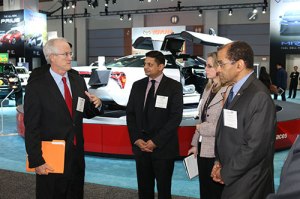By Stephanie D. Shaw
Many of us grew up hearing from our parents, teachers, and television ads, “Don’t Drink and Drive” and “Drinking and Driving Don’t Mix.”
They were right: Alcohol impairment begins with the first drink. Yet, for some, that very simple message seems to have been lost. People want to know, “how much can I drink and drive?” The safe answer is, none. If you’ll be drinking, you need a designated driver, a cab, a ride-sharing service, or some other way home. Studies show that drinking and then getting behind the wheel is simply rolling the dice.
Earlier this month, when we released our 2016 Most Wanted List, there was a lot of media interest in how we discussed substance impairment in transportation.
There has been a lot of talk about the NTSB’s recommendation to lower the legal BAC limit from 0.08 to 0.05, a recommendation that we first made in our 2013 report, Reaching Zero: Actions to Eliminate Alcohol-Impaired Driving.
Many of the news stories following our Most Wanted List announcement have focused on how much a person can drink before getting behind the wheel. Many have reported that for an average-weight man of 180 pounds, two drinks could mean a 0.05 BAC and for an average-weight woman just one drink. While it’s important to know how many drinks may get you to a 0.05 or 0.08 BAC, what’s more vital to consider after a drink or two is what happens to your ability to operate a vehicle safely at those limits.
 In certain circumstances, alcohol degrades driving-related performance at levels as low a BAC of 0.01. In fact, by the time a driver reaches a BAC of 0.08 factors such as lane deviations, divided attention, vigilance, and reaction time are all affected.
In certain circumstances, alcohol degrades driving-related performance at levels as low a BAC of 0.01. In fact, by the time a driver reaches a BAC of 0.08 factors such as lane deviations, divided attention, vigilance, and reaction time are all affected.
Studies of crash risk associated with alcohol use have found that at a BAC of 0.05, there was a 38 percent higher crash risk than for drivers with a zero BAC. At 0.08, the current legal limit, the crash risk was more than two-and-a-half times as much, and at 0.10, the crash risk was nearly five times as high.
Changing the legal per se BAC limits from 0.08 to 0.05 or lower would lead to a meaningful reduction in crashes, injuries, and fatalities caused by alcohol-impaired driving.
But the change we really need is to recognize that while a BAC under 0.08 (or even .05) might keep you safe from a DUI charge, it does not make you safe to drive. The change to a lower BAC will help accomplish the ultimate goal – keeping yourself and others alive. But ultimately the focus should be on being safe on the road, not only safe from law enforcement.
 In the last 15 years alone, one-third of all motor vehicle crash deaths involved an alcohol-impaired driver. In 2014, 9,967 people were killed in a crash involving an alcohol impaired driver – one death every 53 minutes! That’s nearly 10,000 lives lost because as a society we accept that it’s okay to have a drink (or a few drinks) and get behind the wheel.
In the last 15 years alone, one-third of all motor vehicle crash deaths involved an alcohol-impaired driver. In 2014, 9,967 people were killed in a crash involving an alcohol impaired driver – one death every 53 minutes! That’s nearly 10,000 lives lost because as a society we accept that it’s okay to have a drink (or a few drinks) and get behind the wheel.
Your teachers, your parents, and those ads were right: “Don’t Drink and Drive.” Not “Don’t get stumbling drunk and drive,” or “only drink and drive if you’ve only had two or three glasses of wine with dinner.”
A change in the per se limit from .08 to .05 will save lives. Embracing the values our parents and teachers tried to instill, if it is ever universally accepted, will end alcohol impairment on our roads for good.
Stephanie Shaw is a Safety Advocate in the NTSB’s Office of Safety Recommendations and Communications



